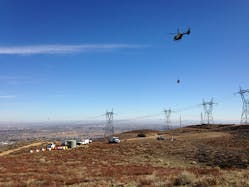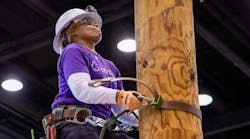Since the 1950s, the Federal Aviation Administration (FAA) has advised electric utilities to install power line marker balls. Over the years, linemen have developed new techniques to install the balls, saving time and increasing productivity in the field.
For example, Southern California Edison (SCE) recently discovered an efficient and safe work method to install 162 marker balls on a transmission project. Through the human external cargo (HEC) method, a helicopter lifted two SCE linemen in an air rescue seat (ARS) on the end of a 75-ft or 100-ft rope. The linemen then placed power line markers on a sky line or shield wire above the 500-kV towers.
On the project, safety was a top priority. As such, the crews participated in a daily combined tailboard briefing to discuss the day’s work, emergent issues and lessons learned. The meetings focused on the safety of the linemen, air ops crew and helicopter team, and addressed any concerns or issues critical to the success of the project.
Marking the Distance
Before the power line marker ball installation even began, SCE’s linemen first marked the distance between each structure and between each ball. The distances were set up asymmetrically on the sky line, which helped with any wind loading.
Initially, the field crews used a rangefinder, which is a laser-activated tool often used for other applications such as hunting or surveying. By looking through the rangefinder, they could obtain a digital distance. The crews also used a tool called a Transit, a computerized and digital device on a tripod that could be used to measure the distance linearly from the point of installation. After taking measurements from the ground, the helicopter pilot also validated the measurements with the GPS on the helicopter.
Next, using the HEC method, the linemen marked the location for each marker ball on the line with a contractor ribbon or clip. The distance between each marker ball was a set distance but also varied depending upon the engineering standards and FAA requirements.
When selecting the power line markers for the transmission project, the SCE engineering department considered reliability and UV endurance. Over time, the sun had faded the old fiberglass power line markers that were installed in other parts of SCE’s service territory, and they began to deteriorate. In contrast, the power line marker balls that were installed on a recent project were comprised of ABS, a type of moldable, vacuum-formed plastic that is covered with a weatherable cap. This color film is UV stable to reduce fading and stay more brilliant over time than fiberglass, which can begin to fade after only a few years.
Attaching Balls to the Line
The power line marker balls came in two halves when they were shipped to SCE. When they arrived, they came arranged in stacks like Pringles potato chips and strapped down to pallets in three different FAA-approved and SCE engineering recommended colors — white, yellow and orange.
On the day of the installation, SCE had a prefabrication team on the ground to assemble the power line marker balls for the installation crew. P&R Technologies’ SpanGuard power line markers are attached to the conductor by spiral preform armor rods that provide a strong grip on the conductor without causing line damage. After preforming them on to a 9/16-inch guy wire, which looked like a fishing lure with the marker balls attached, the prefabrication team hooked them up to the helicopter for transport to the remote landing zone.
Throughout the project, SCE set up specific landing zones in strategic locations. That way, the helicopter pilot could fly to these areas and pick up the prefabbed marker balls without having to return to the original landing zone, saving fuel and time.
The helicopter would fly the linemen to the preset locations, where they would install the marker balls one at a time down the span supported by their ground crew.
Because the balls were staggered on the circuit’s double sky lines going east and west, the linemen focused on installing marker balls on the western sky line, and then came back the other direction and installed them on the eastern sky line; that way, the pilot and linemen did not have to switch their orientation and could instead focus on one line at a time.
Simplifying Installation
When installing the 36-inch marker balls through the HEC method, SCE faced the challenge of working with small bolts in the air. The utility considered several different installation methods, but they all required the lineman to have a small washer in one hand and a bolt and washer in the other.
While working off of a line connected to the helicopter, the linemen would then need to thread the bolt and washers together. Unlike working from the ground, however, the linemen were constantly moving, making this task time-consuming and nearly impossible.
As such, SCE looked for a more hands-free work method for its linemen who were trained in the HEC approach. The utility envisioned the idea of a clip, but despite several attempts, it could not find what it was looking for in the marketplace. At that point, SCE transmission technical support and the HEC team collaborated with P&R Technologies, who started producing the specialized clips to work with the SpanGuard power line marker balls.
The new clip measures about an inch long, is rectangular in shape, is nut welded and designed to slide over the lip of a 36-inch marker ball. Using the clip, a lineman can spread a marker ball open like a clamshell, snap it over a conductor or sky line, and then take a cordless drill to tighten the four remaining bolts, which are held in place by duct tape, and lock them into position. By using something as simple as duct tape, the linemen were able to prevent the clips from shifting while they were being tightened.
Because the invention of the new clip helped to improve the installation process via helicopter and the HEC method, SCE plans to use in again in future marker ball installations.
While the clip boosted the crews’ efficiency, safety was the primary focus because the aerial linemen were working within a tight corridor. For example, the crews closely watched the air space around and below the helicopter, worked with air ops and ensured the line was accurately marked prior to the marker ball installation. Communication between the pilots and the aerial linemen on the seat and harness was also a key component in the project.
As a result, the linemen were able to install the marker balls efficiently and safely. By marking the sky lines, they were also able to keep airplanes and helicopters safer as they approach Southern California.
Daniel Carbajal ([email protected]) is manager of transmission technical support for Southern California Edison. He has been in the utility industry for 35 years and is based in Rialto, California.
The Past and Future of Marker Balls
While power lines throughout North America are marked with marker balls, they were not always designed for simplified installation or long life. George Osgood, president of P&R Technologies Inc., shares a brief overview of the history of these markers, which warn incoming aircraft of the lines.
- In the early1950s in the United States, the Federal Aviation Administration (FAA) began writing its advisories for power line markers both for air traffic and for low-hanging lines across rivers. In the beginning, the linemen installed 24-inch marker balls, but as aircraft became bigger and faster, the FAA wanted a bigger profile on the line. As a result, most of the American utilities opt for 36-inch marker balls, while Canadian utilities, such as BC Hydro in Vancouver, B.C., install 30-inch balls. Internationally, 24-inch power line markers are installed to meet the ICAO standards.
- To help the marker balls to stand out from their environment, the FAA recommended that the balls alternate in three colors: international orange, white and yellow. That way, if one color faded into the surroundings, the other balls on a transmission line would be visible to the pilots. For example, because of the changing seasons, white markers do not work well in snowy locations like Alaska and orange markers do not always work in the fall in New England. On distribution or lower-hanging lines, however, utilities typically install orange, which is the most recognizable color.
- In the United States, the first power line markers were shaped like a traffic cone and adhered to the power line with a clamp. As a result, they waved back and forth in the wind.
- In the late 1950s, P&R Technologies created a fiberglass 20-inch ball that came into halves, but it faded quickly and was also heavier than today’s materials.
- In 1977, P&R Technologies introduced the first ABS vacuum formed plastic marker that offers more brilliant color retention, lighter weight and higher quality. Later, it began producing the marker balls out of ABS, a type of plastic.
- When markers are installed directly on line voltages above 115 kV, fiberglass and plastic markers can burn and melt off high-voltage lines. Therefore, P&R made the entire marker conductive so it could be attached to lines rated 200 kV and up. The company also changed the design of the markers so they include two mounting pads and spiral preform armor rods. That way, they can attach them to the line without having the wind from the helicopter move the ball back and forth like a wind sock.
- Recently, P&R introduced an all-aluminum marker ball, which has been installed by BC Hydro crews. Because they are made of aluminum, the power line marker balls can be attached directly to the live conductor, and the electrical field can pass right through them. They can also handle higher temperatures. For example, when an electric utility replaces an old line with a new line with twice the voltage capacity, the temperature of the line may rise from 250°C to 400°C. Fiberglass and ABS markers often won’t be able to last long in this heat, making aluminum a preferred option for energized lines.
- Because the aluminum balls must be painted to adhere to FAA recommendations, P&R is using an acrylic polyester paint, which is similar to auto paint because it can adhere to the aluminum long term and give it a shiny surface. As a result, the painted aluminum markers can retain their color for about 15 years before the finish becomes dull and starts to diminish.
- Over the years, linemen have installed the marker balls using different methods. For example, they can be attached to the line via helicopter like SCE, or if they are on lower lines, they can be installed with bucket trucks. If the lines traverse a waterway, linemen can install them from a crane loaded on a barge. In addition, crews can wheel themselves out on the power line in spacer carts. In the future, they may even be installed by drones, but this method is dependent on a variety of factors.
- The future of power line marking includes power line markers that can pick up the electrical field around an energized line. Also, markers will feature LED lights that will offer pilots and utilities better marking for day and night operation, thus saving lives and preventing service interruptions.





